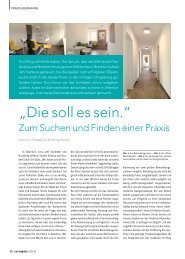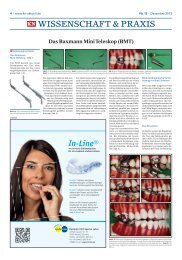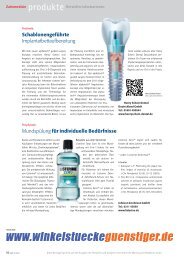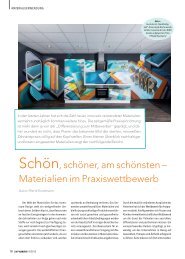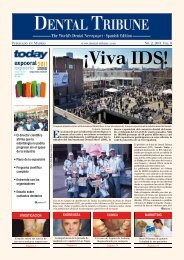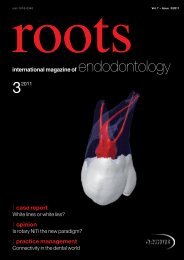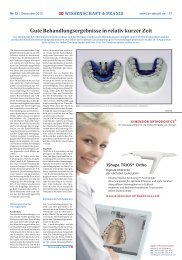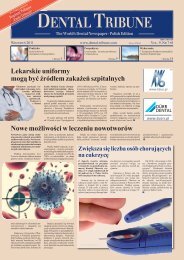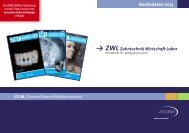Download - Oemus Media AG
Download - Oemus Media AG
Download - Oemus Media AG
You also want an ePaper? Increase the reach of your titles
YUMPU automatically turns print PDFs into web optimized ePapers that Google loves.
12<br />
interview DeNtal tribuNe | april-June, 2010<br />
“Evolution of mini-implants”<br />
Interview with Dr Oliver Hennedige, Singapore<br />
Dr Oliver Hennedige is the<br />
Secretary General of Asia Pacific<br />
Dental Federation (APDF) and<br />
is Executive Director, International<br />
College of Continuing<br />
Dental Education (ICCDE). He<br />
runs a very successful group<br />
dental practice in Singapore,<br />
and lectures and demonstrates<br />
extensively on mini dental<br />
implants. DT India editor, Isha<br />
Goel, had a chance to speak with<br />
Dr Oliver during a workshop,<br />
organized by APDF, ICCDE, and<br />
Indian Dental Association (IDA)<br />
recently in New Delhi, India.<br />
Isha Goel: The dental implants<br />
have been the most influential<br />
change in dentistry and you recently<br />
shared your views about<br />
evolution of mini-implants in a<br />
workshop organized by Asia<br />
Pacific Dental Federation, ICCDE,<br />
and IDA recently in New Delhi,<br />
India. Can you give our readers<br />
an overview of the rationale<br />
for use of mini-implants?<br />
Dr Oliver: Mini dental implants<br />
evolved because of the drawbacks<br />
and failures of the larger<br />
diameter conventional implants.<br />
Conventional implants, while<br />
being promoted as the panacea<br />
for missing teeth, have a high<br />
failure rate as these would require<br />
an invasive procedure,<br />
a very skillful operator, a lot of<br />
understanding, and the use of<br />
a complex range of specialized<br />
and specific instruments. The<br />
complexity has resulted in strict<br />
protocols that hoped to minimize<br />
failures.<br />
While conventional dental<br />
implants are successful in the<br />
hands of an experienced and<br />
competent operator, it generally<br />
failed in the hands of those with<br />
less experience. It took time, and<br />
usually a lot of failures on the<br />
way before a dentist or specialist<br />
became adept in placing conventional<br />
implants.<br />
About 24 years ago, an accomplished<br />
implantologist, Dr Victor<br />
Sendax of America, decided to<br />
question the protocol and rationale<br />
in placing large diameter<br />
implants. He developed the<br />
small diameter implants with a<br />
straightforward protocol, which,<br />
in most instances require no<br />
surgery, and with an initial entry<br />
point with only a pilot drill, he<br />
proposed a self-tapping (screwing)<br />
procedure, which not only<br />
delivered the implant into the<br />
bone but also firmly secured it<br />
into its place. It was minimally<br />
invasive, incredibly less traumatic,<br />
and painless. It allowed<br />
the operator to stabilize dentures<br />
and securely fix crowns and<br />
bridges. Today, it is widely used<br />
worldwide and will, in my view,<br />
replace conventional implants.<br />
There are very few instances<br />
indeed and mini-implants, once<br />
it is understood, will become<br />
standard practice. In fact, there<br />
is an exponential growth of<br />
mini-implants in America and<br />
worldwide, because of simplicity,<br />
extremely high success rate,<br />
and above all patients talk about<br />
the straightforward procedures<br />
and good aesthetic results.<br />
Mini-implants growth is<br />
phenomenal and will be a procedure,<br />
which every dentist of<br />
the present and future generation<br />
will need to know. Its growth<br />
will be driven by patients’<br />
demand.<br />
How do mini-implants osseointegrate<br />
and what is your<br />
experience on their long-term<br />
stability?<br />
The probability of osseointegrating<br />
of mini-implant is much<br />
greater, as it does not utilize<br />
osteotomy (in simple terms,<br />
cutting out large chunks of bone<br />
in order to introduce the conventional<br />
implants). Without the<br />
trauma of this procedure, which<br />
may generate excessive heat,<br />
may ultimately result in bone<br />
necrosis & failure of the conventional<br />
implants, mini-implants<br />
utilize a self-tapping procedure,<br />
which allow, intimate and firm<br />
contact of mini-implant to bone,<br />
once it is introduced.<br />
With the specific design like<br />
a typical screw and surface<br />
coating osseointegration takes<br />
place, I must caution not all<br />
mini-implants and conventional<br />
implants are the same. They<br />
are not generic products, and<br />
you have to choose your miniimplant<br />
carefully, i.e., the company<br />
that produces it.<br />
in immediately extracted socket.<br />
What I do, is measure the length<br />
of the extracted root, choose<br />
a mini-implant at least 2-3 mm<br />
longer than the lenght of the<br />
root, and utilize the same procedure<br />
of the initial use of a pilot<br />
drill, I introduce the miniimplants<br />
into the socket. It is<br />
growth wherever these are<br />
introduced.<br />
What are the advantages and<br />
disadvantages of mini-implants<br />
over conventional implants, and<br />
are there limits for their use?<br />
Really, the advantages of miniimplants<br />
I utilize Mini Drive-Lock,<br />
(MDL), coming from the United<br />
firm and I always pack a bone<br />
augmentation material into the are phenomenal. You<br />
can even use in medically<br />
States of America. It has really socket and stitch tight the opening.<br />
compromised patients with<br />
good properties which allow<br />
easy placement and long-term<br />
stability, especially for crowns<br />
and bridges. The Food and<br />
If the opening is large,<br />
e.g., molar extraction, I place a<br />
membrane over the socket, so as<br />
to prevent washing out of the<br />
controlled diabetes, heart condition,<br />
and for those who are suffering<br />
from Alzheimer where there<br />
is very poor control of jaw<br />
Drug Administration from bone augmentation material. movement, stabilized dentures<br />
Dr Oliver, Dr Anil Kholi, Dr Jeffrey Tsang, and Dr Paramjit Singh (from left to right) during the workshop in New Delhi, India.<br />
America, which is very stringent<br />
in its protocol, has accepted<br />
MDL for long-term use in the<br />
mouth.<br />
I allow initial healing for<br />
about 3-4 weeks and then proceed<br />
to do the prosthetic aspect.<br />
I’ve met with very good results.<br />
I use Perioglas from the USA<br />
My experience having placed for best results.<br />
more than 3000 units, is that<br />
mini-implants not only work,<br />
patients love them and these<br />
are an excellent practice builder.<br />
I can safely say that I enjoy at<br />
least a 95 percent success<br />
rate. I see my patients regularly<br />
for all dental procedures on a<br />
6 monthly recall and miniimplants<br />
An observant selection, appropriate<br />
treatment plan, precise<br />
surgery, and proper design of<br />
prosthesis are essential for optimal<br />
outcome. How will you<br />
grade the success rate of miniimplants<br />
in comparison with<br />
conventional implants?<br />
placed in more than<br />
seven years ago (that is when Frankly speaking, there is<br />
I embarked on mini-implants)<br />
are still functioning well. It<br />
is truly an advancement that<br />
the dental profession cannot<br />
ignore.<br />
really no comparison. Miniimplants<br />
were actually developed<br />
because of the drawbacks<br />
and failures of conventional<br />
dental implants. They are affordable<br />
and are really revolutionizing<br />
Canmini-implants also be placed<br />
in the socket immediately after<br />
the tooth extraction like we do<br />
with the regular implants?<br />
the use of dental implants.<br />
As I predicted, seven years ago<br />
in an article, it will bring about<br />
a paradigm shift in the use of<br />
dental implants. Mini-implants<br />
In my practice and in my lectures,<br />
I teach the use of mini-implants<br />
are so successful that these<br />
are experiencing exponential<br />
with mini-implants or fixed<br />
crowns and bridges have been<br />
a gift to them.<br />
Very old and frail patients<br />
with badly resorbed jaws need<br />
not undergo invasive procedures<br />
of bone build-up. They<br />
can be really benefited with the<br />
use of mini-implants. I’ve placed<br />
mini-implants in such patients<br />
in their late seventies and<br />
eighties. Some of my patients<br />
are still eating well and living<br />
quality lives right into their<br />
nineties.<br />
I believe mini-implants will<br />
continue to evolve and a whole<br />
range of uses will come into<br />
existence, as they are minimally<br />
invasive, easy to use, operator<br />
friendly, patient friendly, and<br />
will be really a boon to patient<br />
care. Mini-implants are affordable<br />
and cost a fraction of<br />
conventional implants.<br />
Dr Oliver thank you very much<br />
for the interview.<br />
DT



